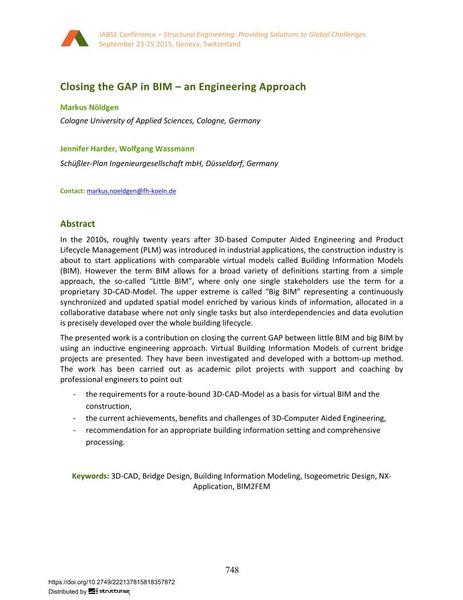Closing the GAP in BIM – an Engineering Approach

|
|
|||||||||||
Bibliografische Angaben
| Autor(en): |
Markus Nöldgen
(Cologne University of Applied Sciences, Cologne, Germany)
Wolfgang Wassmann (Schüßler-Plan Ingenieurgesellschaft mbH, Düsseldorf, Germany) Jennifer Harder (Schüßler-Plan Ingenieurgesellschaft mbH, Düsseldorf, Germany) |
||||
|---|---|---|---|---|---|
| Medium: | Tagungsbeitrag | ||||
| Sprache(n): | Englisch | ||||
| Tagung: | IABSE Conference: Structural Engineering: Providing Solutions to Global Challenges, Geneva, Switzerland, September 2015 | ||||
| Veröffentlicht in: | IABSE Conference Geneva 2015 | ||||
|
|||||
| Seite(n): | 748-755 | ||||
| Anzahl der Seiten (im PDF): | 8 | ||||
| Jahr: | 2015 | ||||
| DOI: | 10.2749/222137815818357872 | ||||
| Abstrakt: |
In the 2010s, roughly twenty years after 3D-based Computer Aided Engineering and Product Lifecycle Management (PLM) was introduced in industrial applications, the construction industry is about to start applications with comparable virtual models called Building Information Models (BIM). However the term BIM allows for a broad variety of definitions starting from a simple approach, the so-called “Little BIM”, where only one single stakeholders use the term for a proprietary 3D-CAD-Model. The upper extreme is called “Big BIM” representing a continuously synchronized and updated spatial model enriched by various kinds of information, allocated in a collaborative database where not only single tasks but also interdependencies and data evolution is precisely developed over the whole building lifecycle. The presented work is a contribution on closing the current GAP between little BIM and big BIM by using an inductive engineering approach. Virtual Building Information Models of current bridge projects are presented. They have been investigated and developed with a bottom-up method. The work has been carried out as academic pilot projects with support and coaching by professional engineers to point out
|
||||
| Stichwörter: |
Brückenentwurf Building Information Modeling 3D-CAD
|
||||
